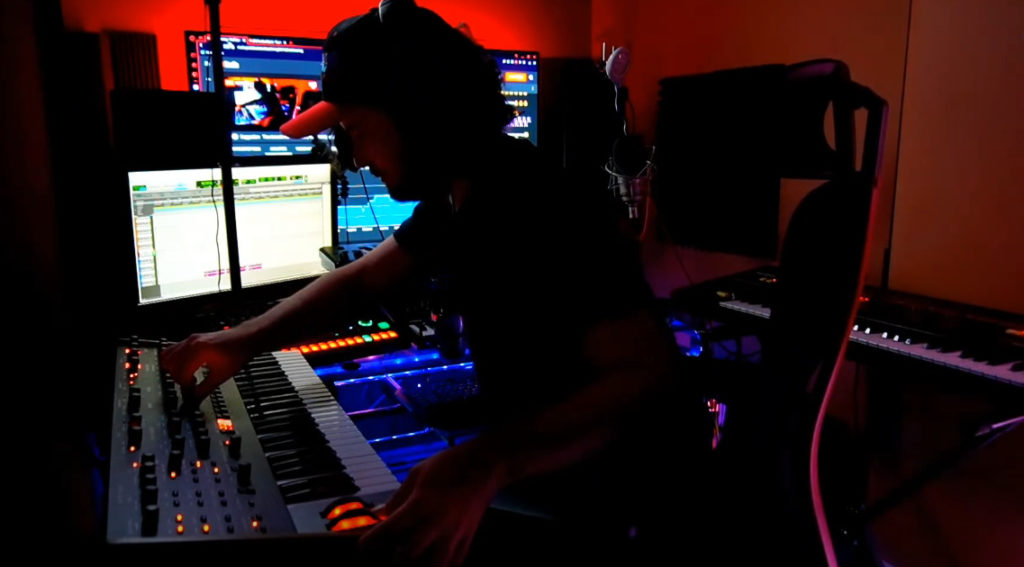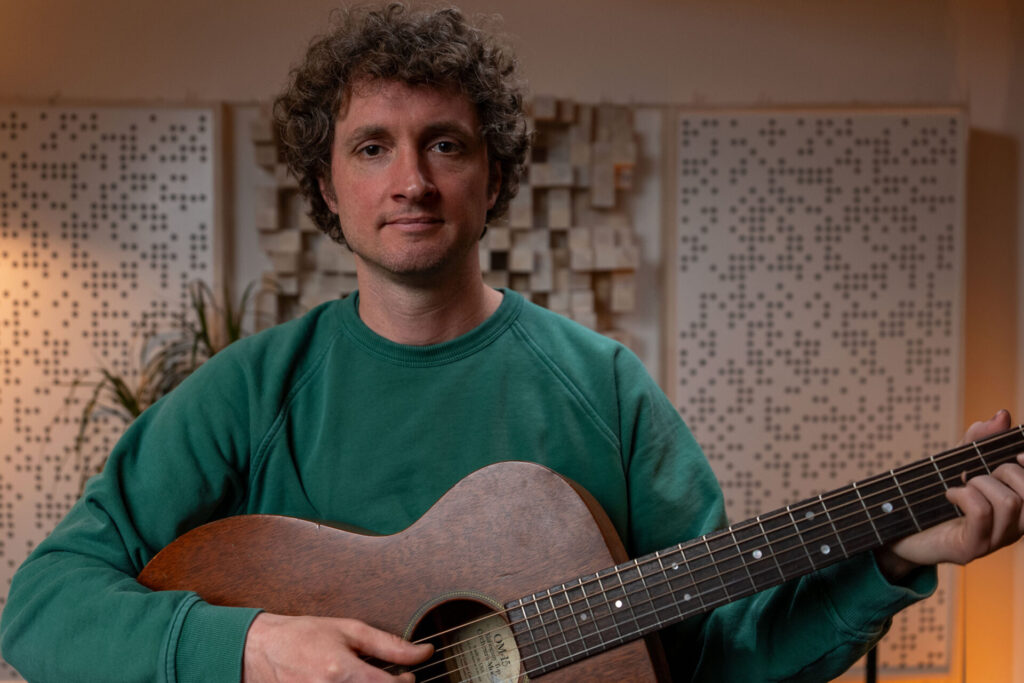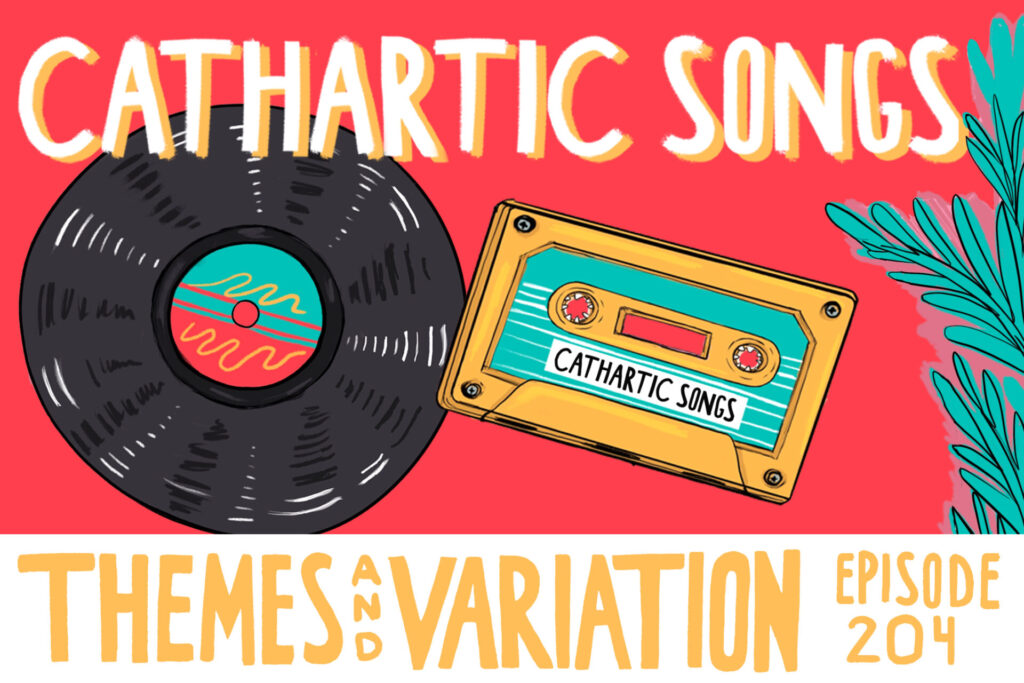This past July, we lovingly (and with much trepedation) launched the Summer of Synthwave Com Truise Remix Contest, encouraging Soundfly members to create their own take on Com Truise’s new track “Dynetics” using his very own stems. Community members from all over the globe whipped up their own remixes for a chance to win amazing prizes put up by Arturia, Kilohearts, Samples From Mars, and D16.
By the time it ended, we were flabbergasted by the sheer number of incredible submissions to the contest, taken aback by the overall level of quality that just seems to flow effortlessly from Soundfly’s artist community, and in a real pickle as Seth and the team convened to decide this year’s winners and runners up…
Yet, one submission kept popping up on everyone’s lists without fail. Mono Memory, a.k.a. Ron C, provided a track that not only transformed Com Truise’s original track into something truly original, it seemed to transport all of us to the same place; a place deeply reminiscent of Seth Haley’s own brand of retrofuturistic epic synth dystopia.
We simply couldn’t look away.
Check out Mono Memory’s “Dynetics” remix below and follow the rest of his music on Spotify here. Mono Memory’s new album, SH, is out now.
The following is my post-win conversation with Arron himself about his work and creative process. Enjoy!
Q: You recently won the Summer of Synthwave Com Truise Remix Contest with your fantastic remix of “Dynetics.” Congrats! How was the process of producing this track for you (fun or laborious)? Was there an overall vision that you started with, or did it organically come together through the process?
Thank you, it really was a shock to get the email through. I have to say, all of the other mixes I heard were excellent. Well done to everyone who entered: you all smashed it.
For me at least, the process of creating/remixing/producing a track always starts off fun and exciting… But, when you hit the mastering stage and the final tweaks start to take shape, it can be pretty exhausting. For this remix in particular, I was jumping around four or five different versions in the end but scrapped it and went in fresh on the day I submitted. Sometimes this has to be done to get a clear head and re-evaluate what you think you are unhappy with. It is the ultimate conundrum with making music: when is it done?
I don’t think I had an overarching vision for the remix, but I definitely wanted to incorporate a lot of my own sporadic sound palettes and mash them into the bedrock of an already solid track from Seth. It is difficult when Com Truise is a major influence, so some of those sounds and melodic ideas were coming through, while I attempted to stay conscious of not riffing too heavily on those themes. But it was a real privilege to bounce off the existing stems and work out where I would take my version.
How did you approach the work? Did the track take a long time to come together or did it go quickly?
This was my first attempt at actually remixing existing stems and adding new parts to a track; I was definitely a bit overwhelmed with where to start on this. The first thing I did, once the stems were in the session (and the bpm was locked in), was to enable elastic audio in Pro Tools and bump up the tempo a bit. I then listened out for a catchy hook, which ended up being part of the synth chord track. I really like the chords and how they kinda ping-pong around with subtle melody and bass counterpoint. As elastic audio was enabled, the pitch also went up by a whole tone so ended up in E♭ — which was an easier key for me to jam around anyway — but liked the feel already from looping this part.
Drums came next; two stereo channels with different routing and kits that I had set up earlier in an existing template. One of the kits is definitely Com Truise-inspired; with punchy kick and toms, while the other one was a bit more of a 808/house feel with more reverb and toppy percussion. Part 1 is a fairly foot-to-the-floor drum layer, while more complex rhythms take shape as the track progresses.
It was also cool experimenting with further counterpoint to the existing melodies within that loop. For that, I turned to my Juno 60 (which I’ve only had a year) and toyed with little riffs that would pop in and out to compliment what was already there. There was also quite a bit of time spent fiddling with bass sounds and finding the actual notes to play; it wasn’t immediately obvious where the right notes should land, but I ended up with E♭ – B – G progression for the opening, which seemed to fit well enough. There are also some call and response riffs with different bass sounds leading up into the first breakdown.
I really jumped around between the stems and my own contributions with hardware/midi until I was comfortable with the intro. I really wanted to keep as much in from the original composition as I could, but opted to not have parts sounding off at once. So I was fairly picky with where I would use certain samples; the cool bass riff was kept for the outro, for example. The riser cymbals punctuate throughout the track. The original drums add an extra layer at the chorus sections. Glitched and faded hats leading into breakdowns, and so on.

Structurally, I wanted it to build up and drop out again, before leading to the first “chorus.” I spent a lot of time trying to get a melody to compliment the chord structure — E♭/C#/B – E♭/C#/G# etc. This was recorded with unison leads on the OB6 and multi-layered in the end.
A cool stem melody lead part was added into the mix here as well, which sat well within the chord structure/new lead lines.
From there, it was just experimenting with different sounds and plug-ins for extra sections (pre/post chorus) that could add a different feel to what else was going on. In hindsight, I think I did structure it somewhat akin to a traditional pop-song structure, albeit with more deviations and breakdowns than average. I actually have a lyrical idea/concept for this remix as well but it hasn’t been recorded yet. All in all, I think I spent around 30 hours on this remix over the course of a week. But the initial ideas during the first session came pretty quickly once I had increased the tempo and found a suitable riff/loop to work from.
How did you arrive at your sound?
In all honesty, I don’t think I have found my sound yet really. I have been involved with putting my own synth-driven spin on video game themes for a good while now, over on YouTube/Bandcamp, which did relatively well for a while, but it has pushed my original stuff to the background a bit. I now plan to change course in the next year or so and really develop a different approach with the new gear and tools I have.
I only started using hardware synths (Juno 60 and OB-6) early last year, which has definitely had an impact on the way I approach synthesis and recording. I’m not so hellbent on midi now and will try to play in parts organically. There is always elastic audio quantizing if I’m particularly terrible some days! Some notable plug-in mentions that I enjoy: Omnisphere, D16 effects, Diva, Predator 2, OB-XD, Massive and Eventide suite.

Who are your biggest inspirations in terms of producers or artists, and did you look towards any particular artist for inspiration here?
The Mono Memory synth project started in 2016 after deciding I was done with guitar music. The synthwave scene had been on my radar since about 2011, but just took a while to give it a go myself. I have a bunch of small EP’s out there that dip into the ’80s aesthetic and vibe, inspired by Lazerhawk, Com Truise, The Glitch Mob, Electric Youth, College, etc. These artists definitely led to the inspiration of having a shot at this kind of music.
As an ’80s kid, the nostalgia for that sound has always been strong. For this remix in particular, I did want to ride the line of staying true to the Com Truise sound but add twists and turns on that formula along the way.
Were you able to put concepts you learned from Com Truise’s Mid-Fi Synthwave Slow-Motion Funk course into action in your remix?
I am still working through parts of the course, but as of writing this, every section has taught me something new, whether it be a general approach or mindset, to more technical use of compression and layering/effects — it’s all helpful. Side-chaining is something I have been a bit lazy with implementing in some mixes in the past, so I’d say it was interesting to hear his take on making it work in Ableton, alongside the likes of multi-band dynamics in smoothing out the mix.
The video accompaniments really help you better grasp what is going on as I find reading can not always be the best way of learning new techniques; seeing and hearing goes a long way.
What brought you to Soundfly originally?
I actually came across an Instagram ad showing off the Com Truise course, which definitely piqued my interest as a fan of his music for sometime. I have not looked into other courses yet, but I really like the format of Soundfly; really well-presented and each section gives you enough to get going and not detract overall from the progress you are making. I will have to see what else is on offer, for sure!
What’s next for you in 2022?
Currently, I am finishing a Silent Hill-inspired album as a homage to some of the great original compositions by Akira Yamaoka (composer for most of the games). This should be out and ready for Halloween weekend; two weeks later for digital stores. Then, it is on to producing a new original EP and trying to get my music out there as much as possible.
This has become a full-time venture for me the past year, so really looking to take it up a notch if possible.
Don’t stop here!
Continue learning with hundreds of lessons on songwriting, mixing, recording and production, composing, beat making, and more on Soundfly, with artist-led courses by Kimbra, Jlin, Kiefer, RJD2, Ryan Lott, and of course, Com Truise: Mid-Fi Synthwave Slow-Motion Funk.




